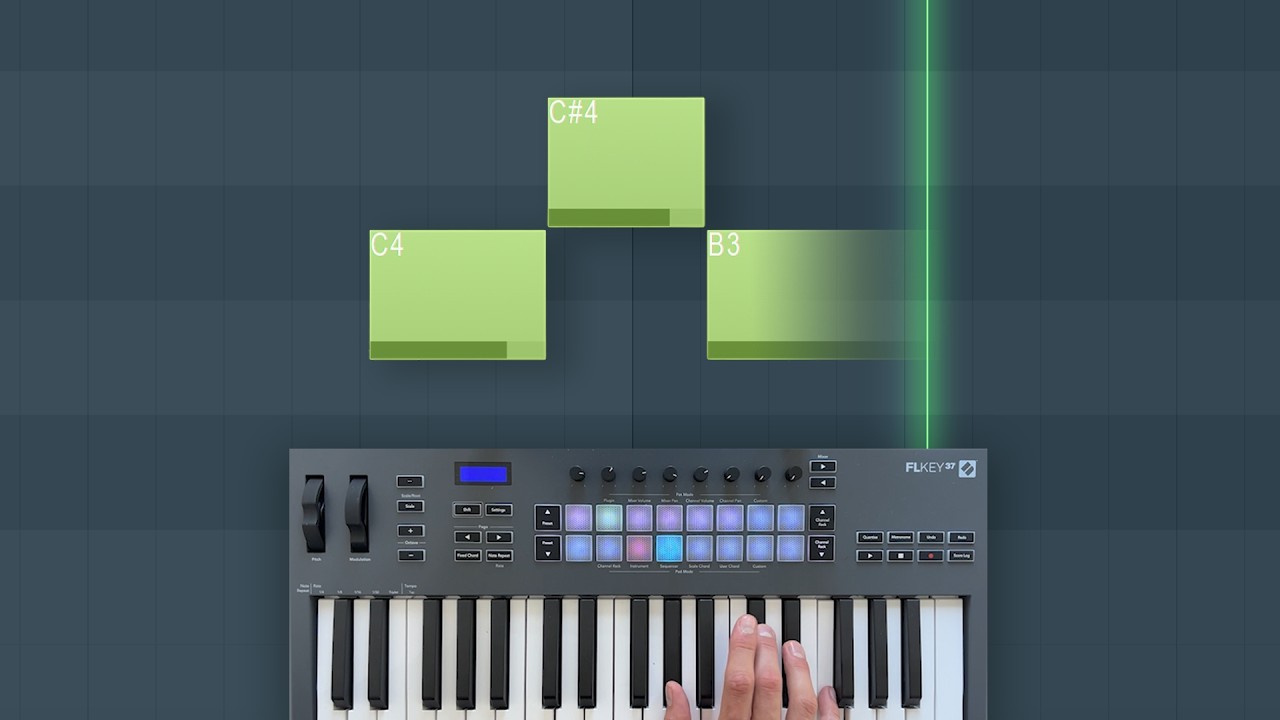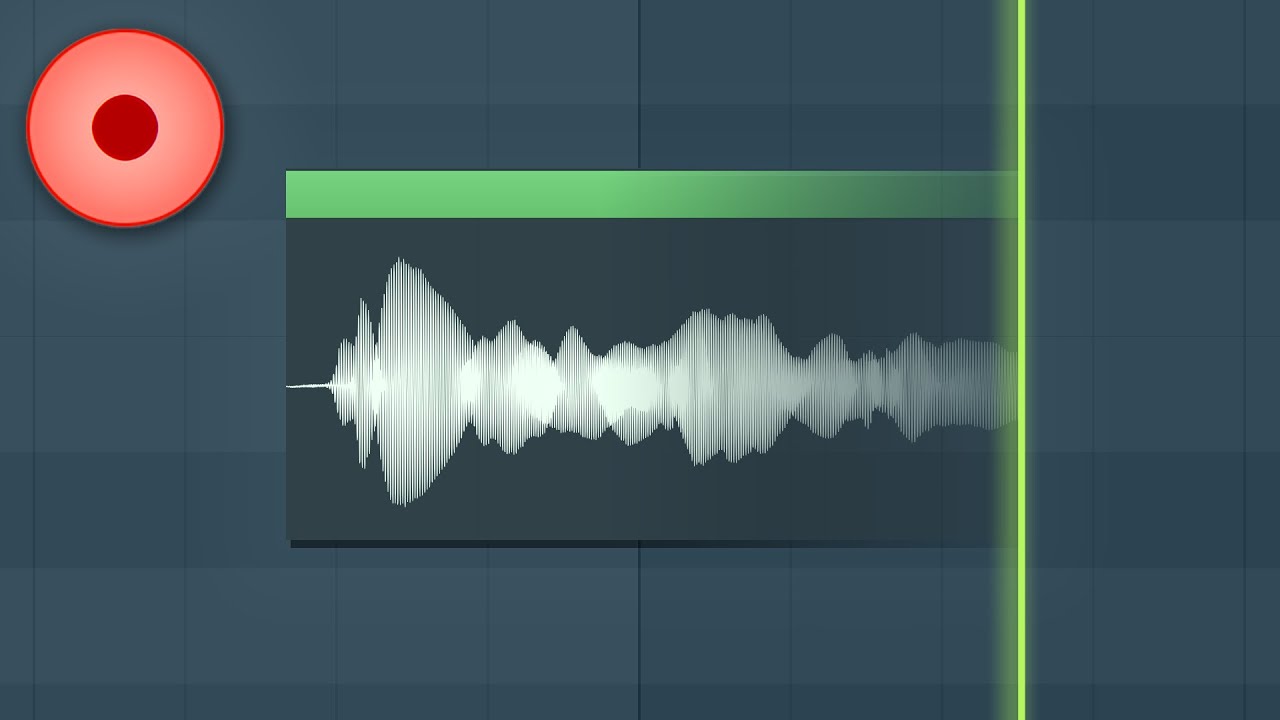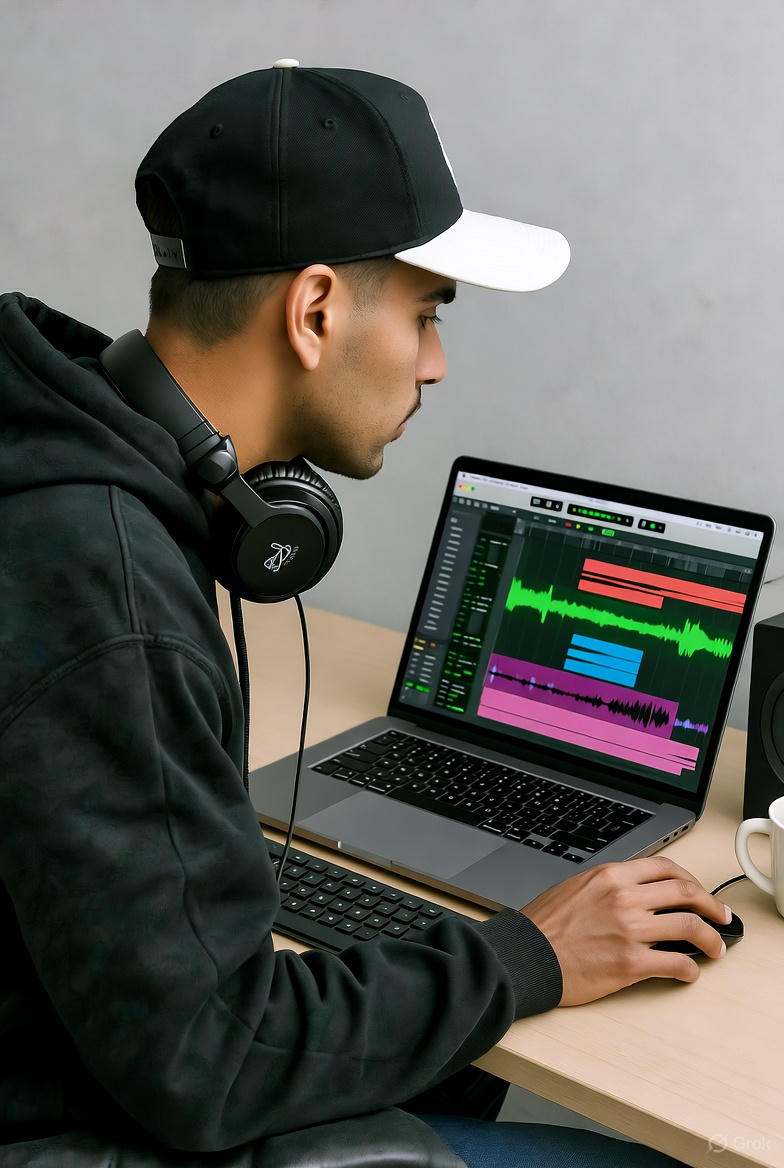!Let Us HELP YOU!
We have a lot of curated content on this blog.
Take this simple 20 second Quiz to Help You
Find The Exact Content You Are Looking For!
Sampling has completely changed the way music is made. Over 90 percent of modern hip hop songs use samples taken from other records, pulling pieces of sound from all corners of culture. Most people think sampling is just copying old tracks, splicing a loop, and calling it new. Yet the real magic happens when producers twist those tiny audio clips into something nobody has ever heard before. This is where creativity turns fragments of sound into totally fresh tracks.
Table of Contents
Quick Summary
| Takeaway | Explanation |
| Sampling transforms sound into art | It repurposes existing recordings into new music, enhancing creativity and musical storytelling. |
| Explore various sample types | Understanding melodic, rhythmic, vocal, and atmospheric samples broadens your creative palette and enhances compositions. |
| Record original samples for uniqueness | Creating custom samples from diverse sound sources allows for innovation and avoids copyright issues. |
| Master sample manipulation techniques | Techniques like time stretching and pitch shifting are crucial for transforming samples into dynamic elements. |
| Utilize effects for sonic enhancement | Effects like reverb and distortion can drastically reshape the character and emotional impact of your samples. |
1: Understand What Sampling Is and Its Importance
Sampling represents a foundational technique in music production where producers extract and repurpose segments of existing sound recordings to create new musical compositions. Music Technology Magazine defines sampling as the digital process of recording a portion of sound from an original source and reimagining it within a fresh musical context.
At its core, sampling allows music producers to transform existing audio material into innovative sonic landscapes. Musical creativity emerges through intelligent manipulation of sound fragments, whether from vinyl records, live performances, movie dialogues, or unconventional sources like environmental recordings.
Key aspects of sampling include:
-
Capturing unique sonic textures that cannot be recreated through traditional instrumentation
-
Establishing unique rhythmic patterns and melodic foundations
-
Paying proper legal and copyright respect to original sound sources
Producers utilize sampling across multiple genres, from hip hop and electronic music to experimental soundscapes. The technique goes beyond mere reproduction, offering a creative method of musical storytelling where historical sound fragments become contemporary artistic expressions.
Successful sampling requires understanding both technical and artistic dimensions. Producers must develop skills in:
-
Identifying compelling sound sources
-
Precise audio extraction techniques
-
Creative sound manipulation
-
Maintaining musical coherence
According to Sound on Sound, sampling represents more than a production technique it is a transformative art form that bridges musical generations and cultural expressions. By thoughtfully selecting and reimagining sound fragments, producers can create entirely new musical experiences that honor original sources while pushing creative boundaries.
Understanding sampling is not just about technical proficiency but about developing a nuanced ear for sonic potential and musical innovation.
2: Explore Different Types of Samples
In music production, samples represent diverse audio fragments that producers strategically incorporate into their compositions. Audio Engineering Society recognizes multiple categories of samples that offer unique creative possibilities for music makers.
Understanding the spectrum of sample types empowers producers to expand their sonic palette and craft more nuanced musical experiences. Musical samples can be categorized into several distinctive groups:
-
Melodic Samples: Short musical phrases from instruments like pianos, guitars, or synthesizers
-
Rhythmic Samples: Drum breaks, percussion loops, and rhythmic patterns
-
Vocal Samples: Spoken words, vocal phrases, or sung segments
-
Atmospheric Samples: Environmental sounds, texture recordings, ambient noise
Melodic samples often serve as foundational elements in genres like hip hop and electronic music. Producers might extract a brief guitar riff, a piano chord progression, or a synthesizer sequence and transform it into an entirely new musical context. These fragments become building blocks for original compositions.
Rhythmic samples represent another critical category, particularly prominent in beat-driven genres. Drum breaks from classic funk and soul records have historically provided the backbone for numerous hip hop and electronic tracks. Mix Magazine highlights how producers can manipulate these rhythmic samples through techniques like chopping, time stretching, and pitch shifting.
Vocal samples introduce another layer of complexity. Producers might use short vocal phrases as hooks, create melodic elements from spoken words, or layer vocal textures to generate unique soundscapes. These samples can range from classic movie dialogues to obscure record collections.
Atmospheric samples offer producers opportunities to create immersive sonic environments. Environmental recordings like rain sounds, urban noise, or industrial machinery can add depth and texture to musical compositions. These unconventional sound sources transform traditional music production approaches.
WEBSITE RESOURCES FOR MUSICIANS
By understanding and experimenting with different sample types, producers unlock endless creative possibilities in music composition.
3: Learn How to Record Your Own Samples
Recording original samples transforms music production from mere reproduction to genuine creation. Sound on Sound emphasizes that unique samples represent the most powerful tool in a producer’s creative arsenal.
Creating personal samples requires understanding both technical and artistic considerations. Producers need high quality recording equipment and a strategic approach to capture compelling sound sources. Check out our guide on sampling in Logic Pro for detailed technical insights.
Essential equipment for sample recording includes:
-
High-quality microphone with broad frequency response
-
Digital audio interface
-
Professional recording software
-
Acoustic treatment for recording space
Sound sources for personal sampling can emerge from unexpected places. Musical instruments provide traditional sampling material, but innovative producers explore broader sonic landscapes. Potential recording targets include:
-
Household objects creating unique percussive sounds
-
Musical instruments played unconventionally
-
Environmental recordings
-
Spoken word performances
-
Specialized sound generation tools
Successful sample recording demands technical precision and creative imagination. Producers must experiment with microphone placement, experiment with unconventional recording techniques, and develop a keen ear for interesting sonic textures.
Recording techniques like close miking, room miking, and contact microphone placement can dramatically alter captured sound characteristics. Each recording approach introduces unique tonal qualities that transform ordinary sounds into extraordinary musical elements.
Before recording, producers should consider legal and copyright implications. Original recordings eliminate potential sampling clearance issues, providing complete creative freedom. Understanding recording fundamentals allows musicians to build a personal sound library that distinguishes their musical productions.
4: Discover How to Edit and Manipulate Samples
Sample manipulation transforms raw audio recordings into dynamic musical elements, turning ordinary sounds into extraordinary compositions. Music Technology Magazine highlights that advanced editing techniques are crucial for creating unique sonic landscapes.
Learn more about sample beats techniques to understand the nuanced art of sound transformation. Sample editing involves precise technical skills and creative intuition.
Key sample manipulation techniques include:
-
Time stretching to alter sample duration without changing pitch
-
Pitch shifting to modify sound frequency
-
Chopping to break samples into smaller segments
-
Layering multiple samples for complex textures
-
Reverse playback for unexpected sonic effects
Professional producers approach sample editing as a sophisticated craft. Precise editing requires understanding digital audio workstation tools and developing a refined sonic sensibility. Producers must consider:
-
Maintaining sample quality during manipulation
-
Preserving original sonic character
-
Creating cohesive musical transitions
-
Avoiding digital artifacts
Audio Engineering Society suggests that successful sample manipulation demands technical proficiency and artistic vision. Digital tools provide unprecedented opportunities for sound transformation, allowing producers to deconstruct and rebuild audio fragments in innovative ways.
Advanced editing techniques like granular synthesis enable producers to break samples into microscopic sound particles. This approach allows unprecedented control over sonic texture, enabling musicians to create sounds that defy traditional instrumentation.
Understanding sample manipulation requires continuous experimentation. Producers should approach editing as a creative exploration, pushing technological boundaries to discover unique musical expressions. The most compelling sample manipulations often emerge from unexpected techniques and fearless sonic experimentation.
5: Experiment with Layering Samples for Depth
Sample layering represents a sophisticated musical technique that transforms individual sound fragments into complex sonic landscapes. Mix Magazine describes layering as the strategic combination of multiple audio samples to create rich, multidimensional soundscapes.
Learn more about sampling techniques in FL Studio to understand the nuanced approach to sample interaction. Effective layering demands precision and creative intuition.
Key considerations for sample layering include:
-
Maintaining frequency balance
-
Preserving sonic clarity
-
Managing overall volume levels
-
Ensuring harmonic compatibility
-
Preventing audio phase cancellation
Professional producers approach sample layering as a delicate sonic architecture. Successful layering requires understanding how different sound textures interact and complement each other. Producers must carefully select samples that:
-
Share complementary frequency ranges
-
Possess unique sonic characteristics
-
Create interesting textural interactions
-
Enhance overall musical composition
Audio Engineering Society suggests that thoughtful sample layering can create depth and complexity impossible with single sound sources. Digital audio workstations provide unprecedented tools for precise sample interaction.
Advanced layering techniques involve manipulating sample envelopes, using subtle volume modulation, and applying strategic equalization. Producers might combine a crisp percussion sample with a warm atmospheric texture, creating a sound that transcends individual sample limitations.
Experimentation remains crucial in sample layering. Each combination offers unique sonic possibilities, challenging producers to develop a refined understanding of sound interaction. The most compelling musical moments often emerge from unexpected sample combinations that defy traditional production approaches.
6: Use Effects to Enhance Your Samples
Audio effects transform ordinary samples into extraordinary sonic experiences, providing producers with powerful tools for creative sound manipulation. Sound on Sound emphasizes that strategic effect application can dramatically reshape musical materials.
Explore our guide to top equalizers to understand how precise frequency modification can elevate sample quality. Effects represent more than technical modifications they are artistic expressions.
Critical audio effects for sample enhancement include:
-
Reverb for spatial depth
-
Delay for rhythmic complexity
-
Distortion for sonic texture
-
Compression for dynamic control
-
Equalization for frequency sculpting
Professional producers view effects as transformative musical instruments. Each effect introduces unique sonic characteristics that can:
-
Expand sample emotional range
-
Create unexpected textural shifts
-
Generate complex harmonic interactions
-
Mask technical imperfections
-
Establish distinctive sound signatures
Audio Engineering Society notes that intelligent effect application requires understanding both technical parameters and creative potential. Digital audio workstations provide unprecedented control over sound manipulation.
Advanced producers approach effects as sculptural tools. Subtle reverb might transform a percussive sample into a dreamy atmospheric element. Careful distortion can convert a clean recording into an aggressive, gritty sound. Compression can tighten rhythmic elements, creating punch and immediacy.
Experimentation remains key in effect processing. Producers should view each effect as a potential sonic adventure, pushing boundaries and challenging traditional sound expectations. The most innovative musical moments often emerge from unexpected effect combinations that redefine sample characteristics.
7: Stay Creative: Finding Unique Sample Sources
Musical innovation emerges from unexpected sonic territories, challenging producers to explore unconventional sample sources beyond traditional recording techniques. Music Technology Magazine highlights that groundbreaking compositions often originate from the most surprising audio environments.
Check out unique synth gift ideas to discover tools that can expand your creative sampling horizons. Creativity requires continuous exploration and willingness to experiment.
Unique sample sources for adventurous producers include:
-
Household objects with interesting acoustic properties
-
Urban environmental recordings
-
Vintage radio broadcasts
-
Mechanical machinery sounds
-
Scientific instrument outputs
-
Natural landscape recordings
Professional sound designers understand that every environment contains potential musical material. Producers should approach sampling with a curious mindset, recognizing sonic potential in seemingly mundane sources. Key considerations for discovering unique samples involve:
-
Developing heightened listening awareness
-
Carrying portable recording equipment
-
Experimenting with unconventional microphone techniques
-
Challenging traditional sound perception
-
Respecting legal recording boundaries
Audio Engineering Society emphasizes that innovative sampling transcends technical skills it represents a profound artistic perspective. Digital technology has democratized sound collection, enabling producers to transform ordinary audio into extraordinary musical expressions.
Advanced producers view the world as an expansive sound library. A creaking door, wind through urban structures, or distant industrial machinery can become rhythmic foundations or atmospheric textures. The most compelling musical innovations often emerge from sounds previously considered background noise.
Below is a comprehensive table summarizing the seven essential sampling techniques every music producer should master, including their core purpose, key actions, and major benefits discussed in the article.
| Technique | Core Purpose | Key Actions/Focus | Main Benefits |
| Understand What Sampling Is & Its Importance | Repurpose and reinvent existing audio | Identify sources, extract, and creatively manipulate sounds | Enables creative storytelling; bridges musical eras |
| Explore Different Types of Samples | Diversify creative palette | Utilize melodic, rhythmic, vocal, and atmospheric samples | Broadens sonic range; fuels composition innovation |
| Record Your Own Samples | Achieve uniqueness and originality | Use quality equipment, unconventional sources, and custom recording techniques | Avoids copyright issues; expands personal sound library |
| Edit & Manipulate Samples | Transform raw samples into dynamic musical elements | Time stretching, pitch shifting, chopping, reversing, granular synthesis | Develops unique sounds; maximizes sonic potential |
| Layer Samples for Depth | Build complex, textured soundscapes | Combine multiple samples, manage balance, frequency, and volume | Creates rich, multidimensional music |
| Use Effects to Enhance Samples | Elevate and reshape character of samples | Apply reverb, delay, distortion, compression, EQ, and other effects | Adds emotion and depth; defines unique sonic signatures |
| Stay Creative: Find Unique Sample Sources | Unlock new sonic possibilities outside tradition | Explore everyday sounds, environmental recordings, unique objects, and innovations | Drives musical originality; inspires innovation |
Take Your Sampling Techniques From Basic to Next-Level Beat-Making
Struggling to transform your sample ideas into unique, pro-quality tracks? Maybe you have read all the top tips about sampling, layering, and using effects, but your beats still sound flat or uninspired. Unlock creative depth by learning how to record your own samples, manipulate them with precision, and layer sounds for that professional polish—using the very tools and methods you just discovered. At How to Make Beats Blog, you will find step-by-step DAW tutorials and in-depth gear reviews to help you master every sampling method, from sampling in Logic Pro to advanced sampling techniques in FL Studio.
Ready to move beyond just reading about techniques? Dive into real-world guides, discover the best equipment, and see exactly how to put creative sampling into action—today. Visit How to Make Beats Blog now and get the edge you need to turn every sample into a hit.
Frequently Asked Questions
What is sampling in music production?
Sampling is a technique used by music producers to extract and repurpose segments of existing sound recordings to create new compositions, allowing for innovative sonic manipulation and musical storytelling.
What types of samples can be used in music production?
Samples can be categorized into melodic samples, rhythmic samples, vocal samples, and atmospheric samples, each offering unique creative possibilities for crafting music.
How can I record my own samples effectively?
To record your own samples, you need high-quality recording equipment, an understanding of acoustic treatment, and a willingness to explore unconventional sound sources, such as household objects or ambient recordings.
What techniques can enhance the manipulation of samples?
Key techniques for manipulating samples include time stretching, pitch shifting, chopping, layering, and utilizing effects like reverb and distortion to transform audio recordings into dynamic musical elements.
Recommended
-
Why Master Your Beats: Understanding the Art of Sound – How To Make Beats Blog
-
How To Make Sample Beats: Guide to Logic Pro’s Quick Sampler



